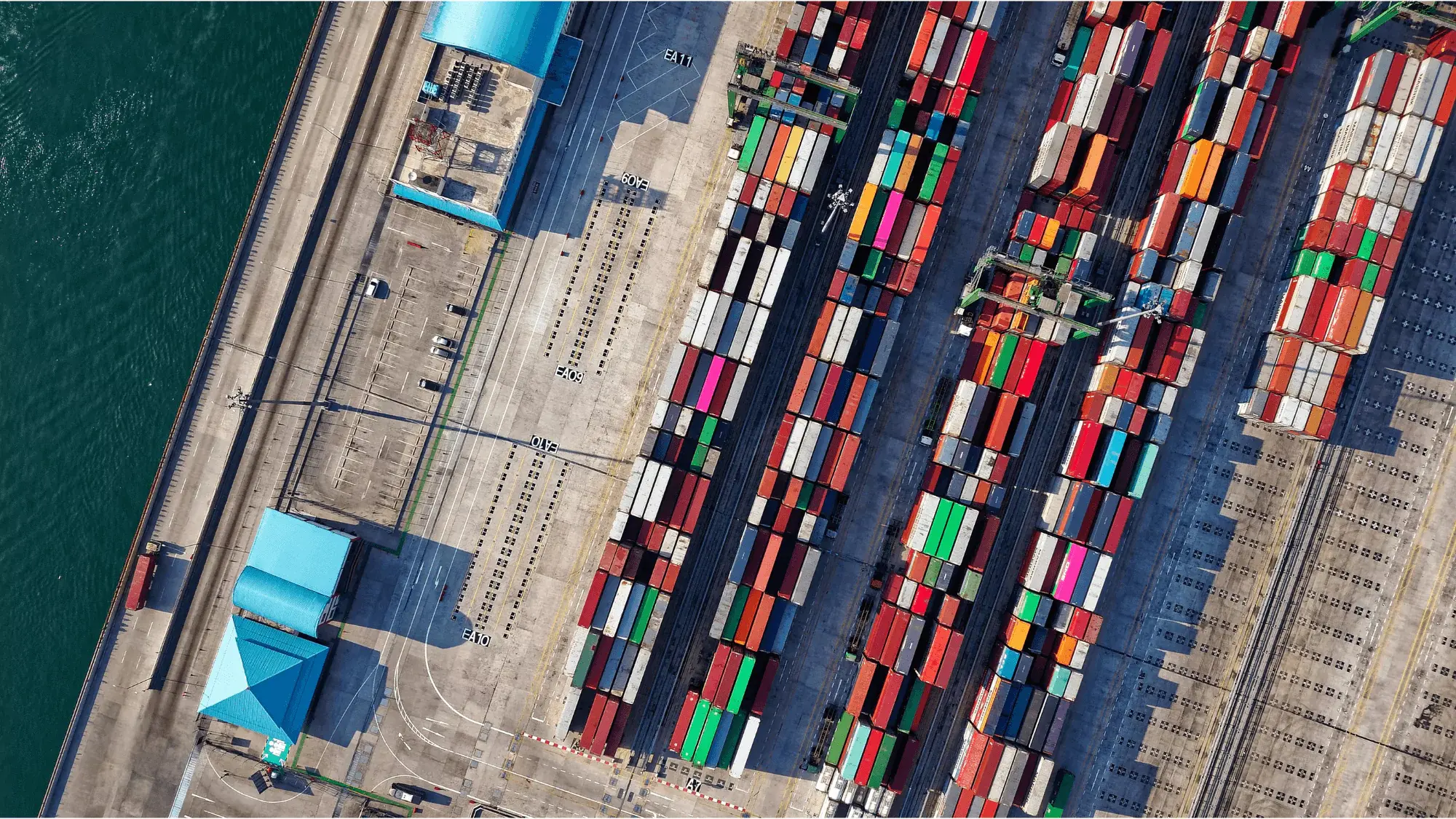
Freight transportation acts as the circulatory system of commerce, connecting suppliers, manufacturers, distributors, and retailers in a complex web of transactions. However, navigating this intricate network requires a clear understanding of its key components, particularly the distinction between inbound and outbound freight.
While seemingly straightforward, these concepts can become nuanced in the context of B2B operations, where multiple layers of suppliers and customers exist within the same supply chain.
Read on to gain a deeper understanding of these critical processes and how optimizing them can enhance your operational efficiency and drive success.
What is Inbound Freight?
Inbound freight encompasses the transportation of goods and materials into a business. It's the first step in a complex chain of transactions that keeps industries running smoothly. This involves the movement of raw materials, components, and finished or semi-finished products from suppliers, vendors, or other business partners to the receiving company's location. This location could be a manufacturing facility, a warehouse, a distribution center, or even a retail store.
Think of a furniture manufacturer receiving shipments of lumber, fabrics, and hardware from various suppliers. Or envision a clothing retailer receiving bulk shipments of apparel from a manufacturer. These scenarios demonstrate inbound freight in action within the B2B landscape. Even a technology company receiving a shipment of servers from a data center provider falls under the umbrella of inbound freight.
Why is efficient inbound freight management so crucial for businesses? It's more critical than many realize; in fact, 54% of companies cite inbound transportation as their biggest supply chain challenge.
First and foremost, it ensures a consistent and reliable supply of materials necessary for operations. Without a steady flow of inbound goods, production can grind to a halt, orders can be delayed, and customer satisfaction can plummet.
Moreover, optimized inbound freight logistics help businesses maintain optimal inventory levels. By accurately forecasting demand and coordinating inbound shipments, companies can minimize storage costs, reduce waste, and avoid the detrimental effects of stockouts or overstocking. In essence, efficient inbound freight management is the bedrock of a well-functioning supply chain, contributing to increased productivity, reduced costs, and improved profitability.
What is Outbound Freight?
Outbound freight, in the B2B world, refers to the movement of goods away from a business and towards its customers or partners. It's the crucial link that connects businesses to their clients, ensuring products reach their intended destinations efficiently and effectively. This encompasses the transportation of finished goods, components, or even raw materials to another business within the supply chain.
Consider a manufacturer shipping its finished products to a wholesaler or distributor. This could involve transporting anything from pallets of packaged goods to large machinery. Or picture a wholesaler distributing goods to various retail locations, ensuring stores are stocked with the products they need to meet consumer demand. A component supplier sending parts to a manufacturing plant also falls under this umbrella. For example, a company that produces microchips might ship these components to a computer manufacturer for assembly.
It's important to note that B2B outbound freight also includes B2C transactions, such as a retailer shipping online orders directly to consumers. While the end customer is an individual, this process is still considered outbound from the retailer's perspective as it involves the outward flow of goods.
Efficient outbound freight management is vital for several reasons. Firstly, it ensures the timely delivery of products, which is crucial for meeting customer demand and fulfilling orders promptly. In the fast-paced business world, delays can lead to lost sales and dissatisfied customers.
Secondly, it contributes to maintaining strong relationships with business partners by demonstrating reliability and commitment to service-level agreements. Consistent and timely deliveries build trust and foster long-term partnerships.
Finally, optimized outbound logistics can significantly reduce transportation costs—studies show companies can achieve up to 30% reductions in operational costs through such optimization. Beyond cost savings, it also improves delivery accuracy and enhances a company's reputation for efficiency and dependability. Effective outbound freight management is a key differentiator in the competitive B2B landscape, where timely deliveries and seamless transactions are paramount.
Inbound Freight vs. Outbound Freight: Key Differences
While both inbound and outbound freight involve the transportation of goods, they represent distinct movements within the intricate network of the B2B supply chain. Understanding these key differences is crucial for effective logistics management and optimizing business operations.
Direction of Flow
The most fundamental difference lies in the direction of movement. Inbound freight focuses on the inward flow of goods into a business. This could be a manufacturer receiving raw materials, a distributor receiving finished goods from a factory, or a retailer receiving stock from a wholesaler. On the other hand, outbound freight deals with the outward flow of goods away from the business. This could involve a manufacturer shipping finished products to a distributor, a wholesaler delivering goods to retailers, or a retailer fulfilling online orders to individual customers.
Types of Goods
The nature of goods being transported also varies between inbound and outbound freight. Inbound freight typically involves raw materials, components, and supplies required for production or resale. Think of a steel mill receiving iron ore, a car manufacturer receiving tires and engines, or a clothing store receiving shipments of new apparel.
Outbound freight in the B2B context can be more diverse. While it often involves finished goods, it can also include semi-finished products, components, or even raw materials moving between different stages of the supply chain. For example, a textile mill might ship fabric to a garment manufacturer, or a plastics manufacturer might send raw plastic pellets to a company that produces molded parts.
Parties Involved
B2B inbound and outbound logistics involve a complex network of players. Inbound freight typically involves interactions with suppliers, vendors, and raw material providers. Outbound freight, on the other hand, can involve a broader range of parties, including wholesalers, distributors, retailers, and even end consumers, in the case of B2C transactions.
Purpose
Ultimately, both inbound and outbound freight serve the overarching purpose of maintaining a smooth and efficient flow of goods throughout the supply chain. Inbound freight ensures that businesses have the necessary resources to operate, manufacture products, and fulfill orders. Outbound freight ensures that finished goods reach their intended destinations, whether it's another business within the supply chain or the end consumer. Both processes are essential for meeting customer demand, optimizing inventory levels, and ultimately driving business growth and profitability.
The Interplay of Inbound and Outbound Freight
Inbound and outbound freight are not isolated processes; they are intricately linked, forming a continuous loop that drives the B2B supply chain. The efficiency of one directly impacts the other, highlighting the need for a holistic approach to freight management.
Inbound Impacts Outbound
Efficient inbound freight management is the foundation for successful outbound operations. Timely and accurate receiving of raw materials, components, and supplies ensures that production schedules are met and finished goods are available for outbound shipment. Delays in inbound freight can lead to production bottlenecks, order backlogs, and missed delivery deadlines, ultimately impacting customer satisfaction and potentially damaging business relationships.
For instance, if a manufacturer experiences delays in receiving crucial components, it may be unable to produce finished goods on schedule. This, in turn, can delay outbound shipments to distributors or retailers, leading to stockouts and lost sales. Conversely, efficient inbound freight management ensures a smooth and predictable flow of materials, enabling timely production and fulfillment of outbound orders.
Outbound Impacts Inbound
The efficiency of outbound freight operations can also significantly influence inbound logistics. When goods are shipped out promptly and efficiently, it frees up valuable warehouse space, allowing for smoother receiving and processing of inbound shipments. This prevents congestion in the warehouse, reduces storage costs, and minimizes the risk of damage or loss of goods.
Furthermore, efficient outbound shipping can create a more predictable demand pattern for inbound materials. By analyzing outbound shipment data, businesses can better forecast demand and optimize their inbound logistics accordingly. This helps to avoid overstocking or stockouts, ensuring that the right materials are available at the right time.
The Importance of Synchronization
Seamless coordination between inbound and outbound freight processes is essential for optimizing the entire B2B supply chain. By synchronizing these operations, businesses can achieve several benefits:
-
Optimized inventory levels: Balancing inbound and outbound flows helps maintain optimal inventory levels, reducing storage costs and minimizing the risk of stockouts or overstocking.
-
Reduced costs: Efficient coordination can lower transportation costs, reduce warehousing expenses, and minimize losses due to delays or disruptions.
-
Improved efficiency: Synchronization streamlines the entire supply chain, improving overall efficiency and productivity.
-
Enhanced customer satisfaction: Ultimately, a well-coordinated freight management system leads to timely deliveries, accurate order fulfillment, and increased customer satisfaction.
When it comes to B2B logistics, recognizing the interconnectedness of inbound and outbound freight is crucial for achieving operational excellence and maximizing business success.
The Power of Optimized Freight Management
In the intricate dance of the B2B supply chain, inbound and outbound freight are inseparable partners. Each relies on the other, forming a continuous flow of goods that drives business success. Mastering both is not merely an advantage but a necessity for companies operating in today's dynamic marketplace.
By understanding the nuances of inbound and outbound freight, businesses can unlock significant potential for optimization. From procuring raw materials to delivering finished products, every step holds the opportunity for increased efficiency, reduced costs, and enhanced customer satisfaction.
Are you ready to streamline your supply chain and gain a competitive edge? Explore Customodal's comprehensive freight management solutions, tailored to the unique needs of B2B operations. Our expertise in transportation, logistics, and freight tech empowers businesses to optimize their inbound and outbound processes, improve visibility, and drive sustainable growth.
Take control of your supply chain logistics and set your business on the path to lasting success.





